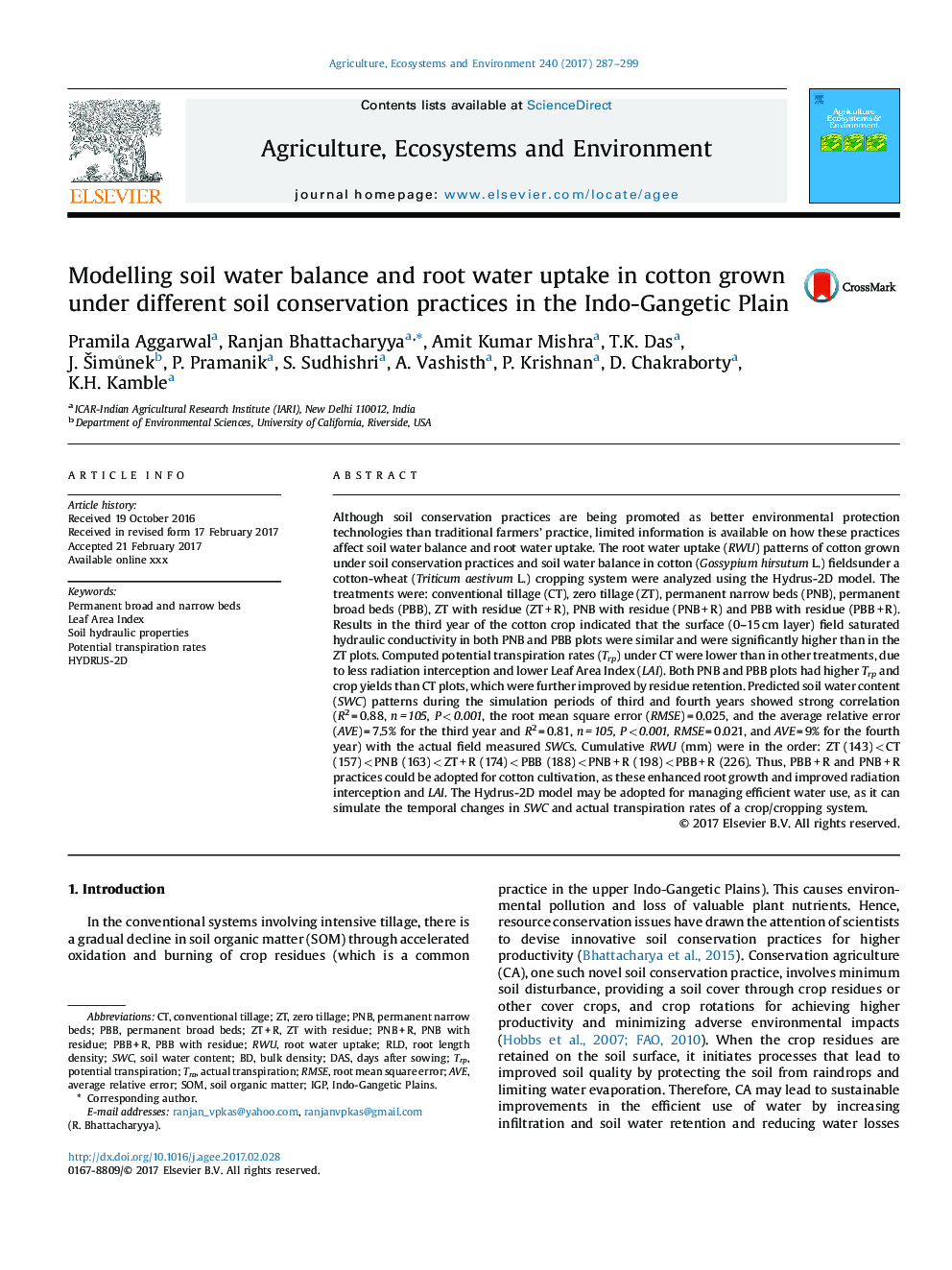| کد مقاله | کد نشریه | سال انتشار | مقاله انگلیسی | نسخه تمام متن |
|---|---|---|---|---|
| 5538177 | 1552012 | 2017 | 13 صفحه PDF | دانلود رایگان |
عنوان انگلیسی مقاله ISI
Modelling soil water balance and root water uptake in cotton grown under different soil conservation practices in the Indo-Gangetic Plain
ترجمه فارسی عنوان
مدل سازی تعادل آب آبیاری و جذب ریشه در پنبه ای که در اثر حفاظت از خاک های مختلف در دشت هندی گانگیک مورد استفاده قرار گرفته است
دانلود مقاله + سفارش ترجمه
دانلود مقاله ISI انگلیسی
رایگان برای ایرانیان
کلمات کلیدی
RMSEPNBIGPAVERWURLDSWCTrpDASSOM - WHOroot length density - تراکم ریشهbulk density - تراکم فلهroot water uptake - جذب ریشه آبSoil hydraulic properties - خواص هیدرولیکی خاکIndo-Gangetic plains - دشتهای هند گنگیکdays after sowing - روز بعد از کاشتRoot mean square error - ریشه میانگین خطای مربعPBB - سازمان ملل متحدLeaf area index - شاخص سطح برگConventional tillage - شخم زدن معمولیZero tillage - صفر خاک ورزیSoil organic matter - ماده آلی خاکSoil water content - محتوای آب خاکtra - میانaverage relative error - میانگین خطای نسبیHydrus-2D - هیدروس 2D
موضوعات مرتبط
علوم زیستی و بیوفناوری
علوم کشاورزی و بیولوژیک
علوم زراعت و اصلاح نباتات
چکیده انگلیسی
Although soil conservation practices are being promoted as better environmental protection technologies than traditional farmers' practice, limited information is available on how these practices affect soil water balance and root water uptake. The root water uptake (RWU) patterns of cotton grown under soil conservation practices and soil water balance in cotton (Gossypium hirsutum L.) fieldsunder a cotton-wheat (Triticum aestivum L.) cropping system were analyzed using the Hydrus-2D model. The treatments were: conventional tillage (CT), zero tillage (ZT), permanent narrow beds (PNB), permanent broad beds (PBB), ZT with residue (ZT + R), PNB with residue (PNB + R) and PBB with residue (PBB + R). Results in the third year of the cotton crop indicated that the surface (0-15 cm layer) field saturated hydraulic conductivity in both PNB and PBB plots were similar and were significantly higher than in the ZT plots. Computed potential transpiration rates (Trp) under CT were lower than in other treatments, due to less radiation interception and lower Leaf Area Index (LAI). Both PNB and PBB plots had higher Trp and crop yields than CT plots, which were further improved by residue retention. Predicted soil water content (SWC) patterns during the simulation periods of third and fourth years showed strong correlation (R2 = 0.88, n = 105, P < 0.001, the root mean square error (RMSE) = 0.025, and the average relative error (AVE) = 7.5% for the third year and R2 = 0.81, n = 105, P < 0.001, RMSE = 0.021, and AVE = 9% for the fourth year) with the actual field measured SWCs. Cumulative RWU (mm) were in the order: ZT (143) < CT (157) < PNB (163) < ZT + R (174) < PBB (188) < PNB + R (198) < PBB + R (226). Thus, PBB + R and PNB + R practices could be adopted for cotton cultivation, as these enhanced root growth and improved radiation interception and LAI. The Hydrus-2D model may be adopted for managing efficient water use, as it can simulate the temporal changes in SWC and actual transpiration rates of a crop/cropping system.
ناشر
Database: Elsevier - ScienceDirect (ساینس دایرکت)
Journal: Agriculture, Ecosystems & Environment - Volume 240, 1 March 2017, Pages 287-299
Journal: Agriculture, Ecosystems & Environment - Volume 240, 1 March 2017, Pages 287-299
نویسندگان
Pramila Aggarwal, Ranjan Bhattacharyya, Amit Kumar Mishra, T.K. Das, J. Šimůnek, P. Pramanik, S. Sudhishri, A. Vashisth, P. Krishnan, D. Chakraborty, K.H. Kamble,
